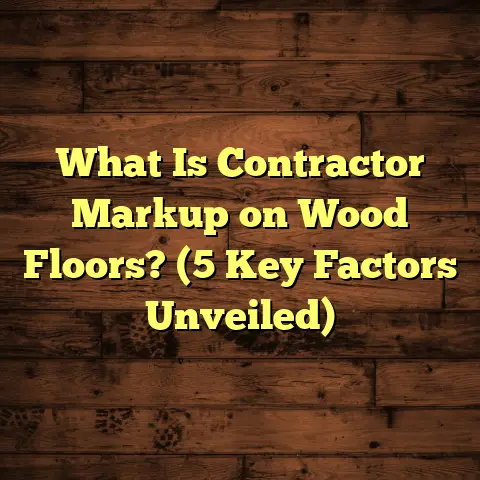What is a Mezzanine Floor in Building? (5 Key Benefits Explained)
Many people think mezzanine floors are just some fancy industrial thing, only suited for big warehouses or factories. I used to think the same until I started working closely with different clients—from small business owners to homeowners—who realized mezzanines could transform their spaces in ways they never imagined. So, what’s the real deal with mezzanine floors? Are they just extra platforms, or can they add serious value to your building? Let me take you through everything I’ve learned over the years about mezzanine floors and why you might want to consider one for your next project.
What Is a Mezzanine Floor?
At its core, a mezzanine floor is an intermediate floor inserted between the main floors of a building. It doesn’t span the whole floor area below and usually doesn’t count as a full story in the building’s floor count. Imagine a sturdy platform hovering inside a tall room—that’s your mezzanine.
These floors are typically built inside spaces with high ceilings—think warehouses, factories, big retail stores, or even homes with double-height rooms. The idea is to use that vertical space that often goes wasted. Instead of expanding outward or moving to a bigger place, you build up.
Mezzanines are supported by columns or walls and can be made from steel, wood, concrete, or combinations of these materials. Their design can be permanent or modular and tailored to your needs, whether it’s storage, office space, retail display, or even living areas.
How Does a Mezzanine Floor Differ From Other Floors?
You might wonder: “Isn’t this just another floor?” Not exactly. Mezzanines are distinct because of their partial coverage and integration within existing spaces. Unlike full additional floors that require significant structural alterations or external extensions, mezzanines fit within your current building shell.
From what I’ve seen over many projects, this difference is key—it means you can add usable space without the headaches of full construction projects. Plus, mezzanines often bypass some zoning restrictions because they don’t increase the building’s official height or footprint.
Common Materials Used in Mezzanine Construction
- Steel: Most popular for commercial mezzanines due to strength and durability.
- Wood: Great for residential or light-use mezzanines because it’s cost-effective and aesthetically pleasing.
- Concrete: Used in some permanent installations—heavy but very sturdy.
- Composite Systems: Combining steel frames with wooden decking for balance between strength and design flexibility.
Each material comes with pros and cons depending on your budget, intended usage, and architectural style.
5 Key Benefits of Mezzanine Floors Explained
Here’s where things get interesting. I’ve installed and designed many mezzanines, and these five advantages always come up as reasons my clients love them.
1. Maximize Space Without Moving
Let me ask you this: Have you ever felt cramped in your office or home but didn’t want the hassle or cost of moving? That’s exactly where mezzanines shine.
I remember working with a small e-commerce business owner who was struggling with limited warehouse space. Their building had 18-foot ceilings but only one ground floor. We designed a mezzanine that added nearly 50% more storage without changing the building’s footprint.
This is not just my opinion—studies show that buildings with ceilings over 12 feet have potential mezzanine space that can increase usable floor area between 30% to 100%. If you have a warehouse or even an office space with extra vertical room, you’re sitting on hidden square footage.
Tip: Measure your ceiling height before exploring options. Anything above 12 feet could be suitable for a mezzanine. Even if you have just 14 feet, you can fit a low-profile mezzanine for storage or lightweight office use.
2. Cost-Effective Expansion Compared to Traditional Building Additions
Building an extension or adding another full story can drain your budget fast. I’ve seen clients get sticker shock when they get quotes for new construction—sometimes over $150 per square foot depending on location and complexity.
Mezzanines typically cost between $25 to $75 per square foot depending on materials and design complexity. This means you can often get twice or even triple the new space for the same money.
For example, a retail client wanted extra display space but couldn’t afford to move to a bigger store. A steel mezzanine installed in just two weeks gave them more than 40% additional retail floor area at one-third the cost of relocating.
Plus, shorter installation means less downtime for your business. In one warehouse installation I supervised, we completed the mezzanine in under 10 days—much faster than waiting months for permits and construction of an addition.
My advice: Get multiple quotes but always ask for detailed breakdowns. Sometimes cheaper upfront costs hide future maintenance expenses or don’t include necessary reinforcements.
3. Flexible Design Tailored to Your Needs
One of the things I love about mezzanines is how customizable they are. You can design them to fit almost any purpose or style.
I once helped a startup design an office mezzanine inside their open-plan warehouse space. The lower level was production while upstairs they created private meeting rooms and quiet workspaces with glass walls letting in natural light. They even added a coffee nook on the mezzanine!
Retailers use them for additional display areas or cashier counters without sacrificing floor flow. Homeowners create loft bedrooms, reading nooks, or game rooms above living areas.
The design possibilities are huge:
- Open railing vs solid walls
- Staircase placement and type
- Load capacity customization
- Lighting integration
- Fire safety features
You can go as simple or elaborate as your budget and imagination allow.
Pro tip: Think ahead about wiring, HVAC, and fire exits during design so your mezzanine functions seamlessly within your building.
4. Improved Workflow and Organization
In industrial and commercial settings, mezzanines not only add space but also improve workflow efficiency.
I worked with a food packaging company that was struggling to keep packing areas separate from storage zones due to limited floor space. By installing a mezzanine dedicated solely to packing above the storage area, they reduced cross-contamination risks and sped up their process by about 15%.
Warehouse studies back this up: vertical separation via mezzanines can increase storage capacity by 50-60% while improving operational efficiency up to 20%. When different activities are stacked instead of sprawled out horizontally, it cuts down walking time and clutter.
Even in offices, separating departments vertically rather than horizontally can foster better communication within teams while reducing noise distractions.
5. Adds Significant Value to Your Property
When it’s time to sell your property—whether commercial or residential—having a mezzanine can make it more attractive and valuable.
I’ve advised clients preparing properties for sale who installed mezzanines before listing. The feedback? Buyers loved the extra functional space without having to expand the building footprint.
Real estate data suggests properties with flexible interior layouts such as mezzanines can fetch 5% to 15% higher prices depending on market conditions and property type. Plus, they tend to sell faster because they stand out in listings.
For homeowners, think of it like adding usable square footage without increasing property taxes tied to official floor counts in some regions.
Practical Advice From My Experience With Mezzanine Floors
If you’re thinking about adding one, here are some lessons I’ve learned along the way:
Plan Your Load Carefully
What you put on your mezzanine affects how strong it needs to be. Storage shelves filled with heavy equipment need much stronger supports than an office lounge area.
In one project, a client underestimated load requirements for industrial racking on their mezzanine. We had to reinforce parts later which increased costs and downtime.
I always recommend doing a full load analysis upfront with engineers or qualified contractors so you don’t run into surprises later.
Know Your Building Codes
Every place has rules about mezzanines—especially around fire safety, ceiling heights, exits, and structural standards.
Some local codes require additional fireproofing on mezzanines or specific stair dimensions. Others might limit how much area you can cover inside the existing space.
Consulting local building authorities before starting design saves headaches down the line. I’ve seen projects delayed for months simply because proper permits weren’t obtained early enough.
Choose Materials Wisely
Steel is king for commercial applications because it holds up well over time and supports heavy loads without bulky columns.
Wood is great for residential or light commercial use where aesthetics matter more than heavy-duty strength. It’s also usually cheaper upfront but may require more maintenance long term.
Concrete is rare but useful in very permanent setups where vibration absorption or fire resistance is key.
Sometimes combining steel frames with wooden decking offers the best balance of durability and design flexibility.
Lighting and Ventilation Matter
Adding a floor inside an existing room can block natural light or airflow if not planned carefully.
Using open railings, glass panels, or translucent materials helps keep spaces bright and airy rather than dark caves below decks.
Also consider how HVAC systems will reach your new level—sometimes ductwork and vents need rerouting which affects costs.
Work With Experienced Professionals
This one cannot be stressed enough! Mezzanines need precise engineering especially when supporting heavy loads or people regularly accessing them.
I always advise clients to hire contractors who specialize in mezzanine construction—not just general builders—to ensure safety and compliance with all regulations.
A Personal Story: How One Mezzanine Transformed a Small Bakery
Here’s something close to my heart. A few years ago, I worked with a local bakery that was bursting at the seams in their tiny shop. They had tall ceilings—about 18 feet—but all production happened on one cramped floor.
We designed a steel mezzanine above their packing area that served two purposes: workspace for dough preparation on top and ingredient storage shelving underneath. This simple addition doubled their usable area without any expansion outside the building.
The owner told me business boomed after that because they could increase output without renting more space or adding shifts. They even added large windows on the mezzanine level for natural light which improved working conditions dramatically.
This project showed me how mezzanines aren’t just practical—they improve lives and businesses by making spaces work smarter.
Data Insights On Mezzanine Floors You Should Know
| Factor | Data / Statistic |
|---|---|
| Average Ceiling Height Needed | Minimum ~12 feet (3.6 meters) |
| Space Added | Typically +30% to +100% usable floor area |
| Cost Range | $25 – $75 per square foot (depends on materials) |
| Installation Time | Days to weeks (depending on size & complexity) |
| Efficiency Gain in Warehouses | Up to 20% workflow improvement |
| Storage Capacity Increase | Up to 60% boost with vertical solutions |
| Property Value Increase | 5% – 15% premium based on property type |
Frequently Asked Questions About Mezzanine Floors
Q: Can I build a mezzanine in my home?
Absolutely! If your ceilings are high enough (generally over 12 feet), you can add loft bedrooms, home offices, or reading nooks using mezzanines. Just check local codes first.
Q: How long does installation take?
Small mezzanines might take just a few days; larger commercial ones could take several weeks depending on complexity and permitting processes.
Q: Will I need special permits?
Usually yes—building permits are required along with compliance with fire safety regulations and structural codes. Always check with local authorities before starting work.
Q: What about stairs?
Mezzanines require safe access via stairs that meet code dimensions. Options range from traditional staircases to spiral stairs if space is tight.
Q: Can I use a mezzanine for heavy equipment?
Yes—but make sure load requirements are accurately calculated so beams and supports handle the weight safely.
Wrapping Up My Thoughts on Mezzanine Floors
So there you have it—a deep look at what mezzanine floors are and why they’re worth considering whether you own a business or home. They offer smart solutions to space problems without breaking the bank or needing major construction projects.
From maximizing unused vertical space to improving workflow and boosting property values, these intermediate floors pack a punch far beyond their size.
If you ever find yourself wondering what to do with high ceilings or cramped spaces, don’t overlook the power of a well-designed mezzanine floor. And if you want advice tailored specifically to your building or project goals, reach out—I’m always happy to share what I’ve learned through hands-on experience!
Got more questions? Just ask—I’m here to help!





